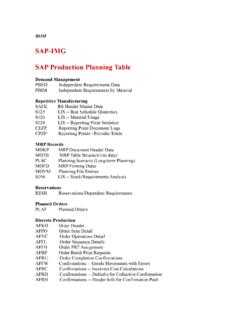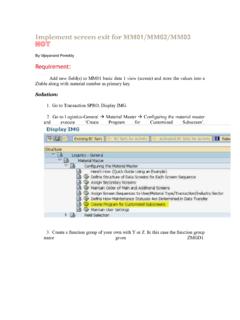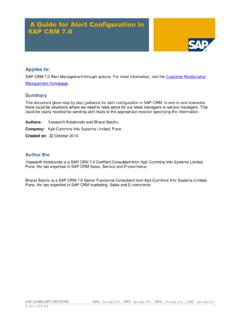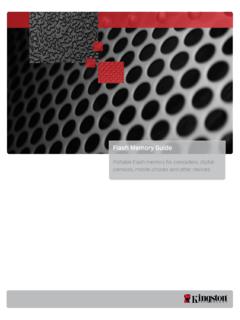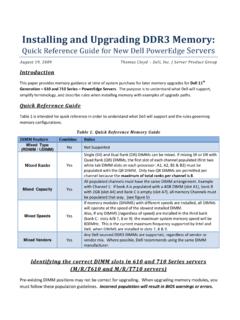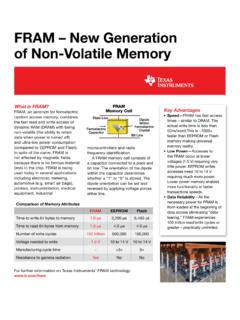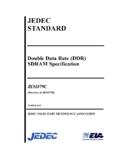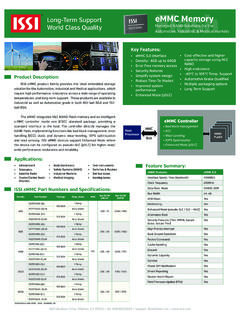Transcription of Shared Memory Programming: Now share objects …
1 Shared Memory programming : now share objects into Shared Memory in the fastest way and with fewer steps SAP DEVELOPER NETWORK | BUSINESS PROCESS EXPERT COMMUNITY | 2006 SAP AG 1 Shared Memory programming : now share objects into Shared Memory in the fastest way and with fewer steps Applies to: SAP NetWeaver Application Server release equal or higher than Summary This article deals about the technique of sharing the class instances and anonymous data objects into Shared Memory . This has got many advantages over the earlier Memory sharing techniques in ABAP in terms of flexibility, speed and performance volumes for sharing data from within ABAP programs.
2 Author(s): Priti Mulchandani Company: SAP Labs India Pvt. Ltd. Created on: 27 December 2006 Author Bio Priti is working as development specialist in SAP Labs India Pvt. Ltd. from last 2 years, with 3 and half years of total SAP experience. She has mostly worked on different customer specific projects related to area of IS-AFS and has keen interest on anything new in ABAP. Shared Memory programming : now share objects into Shared Memory in the fastest way and with fewer steps SAP DEVELOPER NETWORK | BUSINESS PROCESS EXPERT COMMUNITY | 2006 SAP AG 2 Table of Contents Applies to.
3 1 1 Author 1 Why Shared Memory and 3 Some Basics about Shared object 3 How to Use SOM Simple Export and Import 6 9 10 Shared Memory programming : now share objects into Shared Memory in the fastest way and with fewer steps SAP DEVELOPER NETWORK | BUSINESS PROCESS EXPERT COMMUNITY | 2006 SAP AG 3 Why Shared Memory and History Performance, Long run times, Avoiding database tables for sharing few changing contents from one program to another was all pointing to one thing share your data through Memory . Well we had few techniques before, to start with EXPORT FROM and IMPORT TO ABAP Memory but within current main session.
4 Then came; SPA/GPA mechanism. We were able to share data for few fields across External Sessions via SAP Memory . Of course this was not really comfortable, we wanted more- as and when our program sizes grew, the requirement of data for sharing across sessions and across users was a need in a really speedy way. So SAP made it possible by allowing us to store huge data and complex structures through help of Cluster Tables . All these techniques internally copy cluster data from any kind of Memory to our own roll area or context of the program, which takes fair amount of time in case of huge data and many users.
5 Sometimes we even felt database tables will be faster and easier way of programming rather than Memory sharing. So can t we write simple program with good performance whenever we want to share data via Memory access. Well the answer now is Yes . We have now something called Shared object Memory . So; is this kind of Memory really new? Not Really! We already had something called Shared Memory at application server level. The difference lies in the word object ;-). But it meant a lot and like everything now being converted to OO, Memory programming also got adapted to it in ABAP.
6 The idea is, we can store instances and hence the data in the extended place known as Shared object Memory . Actually all of us have already seen Shared Memory access but we never realized that ABAP runtime uses it for its own system programs. For example, we could see the best use of Shared Memory in Workbench SE80, when we shift from one object to other, when we double click on some db table name to switch to SE11, when we debug using new ABAP debugger to see the contents at runtime, when we double click on some FM/subroutine and come back to original So this kind of Memory was always there Everywhere.
7 Some Basics about Shared object Memory The idea is that SOM ( Shared object Memory ) is available at application server level hence it can be accessed across transactions and can be Shared among the different users in effective way. We can now come to actual part and its use. At programming level, we will be dealing with One Area class, Root class, one write program, one read program and tool to define SOM. There are few terminologies though, so let s understand those first: Transaction SHMA simple transaction to define Shared Memory areas and its properties, this is as easy as using SE24 or SE37.
8 Shared Memory programming : now share objects into Shared Memory in the fastest way and with fewer steps SAP DEVELOPER NETWORK | BUSINESS PROCESS EXPERT COMMUNITY | 2006 SAP AG 4 Fig 1: Transaction SHMA Defining Shared Memory Area and its properties Area Just think that you have to give a new name and reserve some piece of the SOM for sharing your own object -something like area for building your own house. Technically system differentiates one AREA from other AREA by some properties/characteristics. A class with the same area name gets automatically generated once you define your area in SHMA.
9 Area Instance Can be compared with different instances at runtime of any usual class, but truly speaking it s not the OO instance. It is again a sub portion of the defined area, which actually gets filled with data through our programs. We can export multiple real OO instances (multiple sets of data) from our programs to different SOM area instance. Shared Memory programming : now share objects into Shared Memory in the fastest way and with fewer steps SAP DEVELOPER NETWORK | BUSINESS PROCESS EXPERT COMMUNITY | 2006 SAP AG 5 Fig 2: SOM Area instances Root Class One of the very important properties of the AREA that we will define using SHMA.
10 Truly this is the class whose instance (mentioned above as real OO instance), we will be storing in SOM from our program. Any access to area instance is always through root instance. This class is same as any other global final class but should necessarily have a property called Shared Memory Enabled Area Instance Version/Versioning Very unique concept that we didn t have so far. If a reader is reading the contents of particular SOM instance and the writer also wants to write or update new contents in same instance, then a new version gets generated every time.
